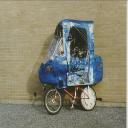Yahoo Answers is shutting down on May 4th, 2021 (Eastern Time) and the Yahoo Answers website is now in read-only mode. There will be no changes to other Yahoo properties or services, or your Yahoo account. You can find more information about the Yahoo Answers shutdown and how to download your data on this help page.
Trending News
Why are train tracks always lined with gravel?
with the exception of at railroad crossings [where cars pass over the tracks], train tracks always seem to be surrounded or lined with gravel underneath the tracks and on a few feet on either side. you don't see tracks laid on top of cement or dirt or sand or grass or asphalt... always gravel.
anyone have a logical explanation?
13 Answers
- tgeorge12000Lv 41 decade agoFavorite Answer
Its not economical to use concrete or asphalt.If you didn't cover the dirt bed with gravel erosion would always be washing out the road bed.Its a combination of economics and drainage, erosion control that makes gravel most popular......George
- Anonymous1 decade ago
Ballast is exactly right and for the reasons stated and a few more.
As rail heats and cools there is a lot of expansion and contraction, the ballast is there to hold the track from moving.
Crushed rock works best as it has countless sharp edges form the broken rocks that actually dig into the sides and bottom of the ties and hold it in place.
when the track moves and shifts, which is does constantly it is a relatively simple matter for the track crews to move it back into position. In the "good old days" it was done by hand, now by machines, but exactly the same way, pick the track up, put it where it belongs and tamp the ballast back in.
With a gravel ballast system, when ties need replaced it is also realitively easy, pull the spikes, push out the old one and push in a new one, concrete would not be nearly as versatile.
I have worked on tracks that were of such low density that grass was growing in and around the ties, that doesnt work very well but it looks rather quaint LOL.
Concrete would break, it simply cannot move as much as necessary, asphalt for the same reason, and once either started cracking, it would need replaced, it cannot be renewed as gravel can.
- 1 decade ago
the gravel makes for an excellent foundation for the tracks. The gravel foundation is larger than the actual tracks to avoid erosion under the tracks and to properly transmit the effort to the ground. Concrete foundations for hundreds of kilometers would be too difficult to make and the concrete should be much much thicker than for example in a road foundation. Even so, the concrete would brake if the ground settles even a few centimeters. gravel is great for tracks ;)
- Anonymous5 years ago
There is no safe way to cross. If there is an obstruction, call to have the trains stopped before a train hits the obstruction. If using a phone is not possible, then walk along side (but not on) the track in the direction opposite the direction in which the trains go and flag down the first train you see. After you explain the situation, the train operator will radio the railroad dispatcher, who will stop the trains on the obstructed track and send someone who knows how to remove the obstruction safely.
- 1 decade ago
This photo shows tracks that are set in concrete:
http://i134.photobucket.com/albums/q119/hotbike/00...
It's a matter of cost. Track could be laid in concrete, like I showed you in the picture.
The "gravel" used by railroads is called "Ballast" and is rocks between 2 1/2 and 3 inches is size.
It is used for drainage, otherwise, the tracks would sink into mud when it rains.
- Anonymous1 decade ago
the gravel has 100% compaction at all times wet or dry without being tamped or rolled into place...all the big pipes under the street are setting on a gravel bed as well for the same reason...
many years in the mining and construction industry
- Anonymous1 decade ago
It is for support so the tract is where it is gravel is the best and cost wise choice and easy to use. Concret whould crack under wieght of 1 train and water wlhould not drain of.
- Anonymous1 decade ago
They have to have gravel for drainage, and a solid foundation that will "give". If you ever see a train go over the tracks you will see how the rails "give". It needs to do this in order to prevent damage to the rails themselves.
- Anonymous1 decade ago
1st of all the gravel is called ballast, ballast is there to prevent shifting in the ties, drainage, and weed control




